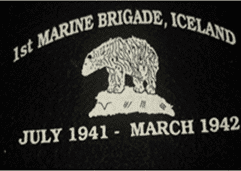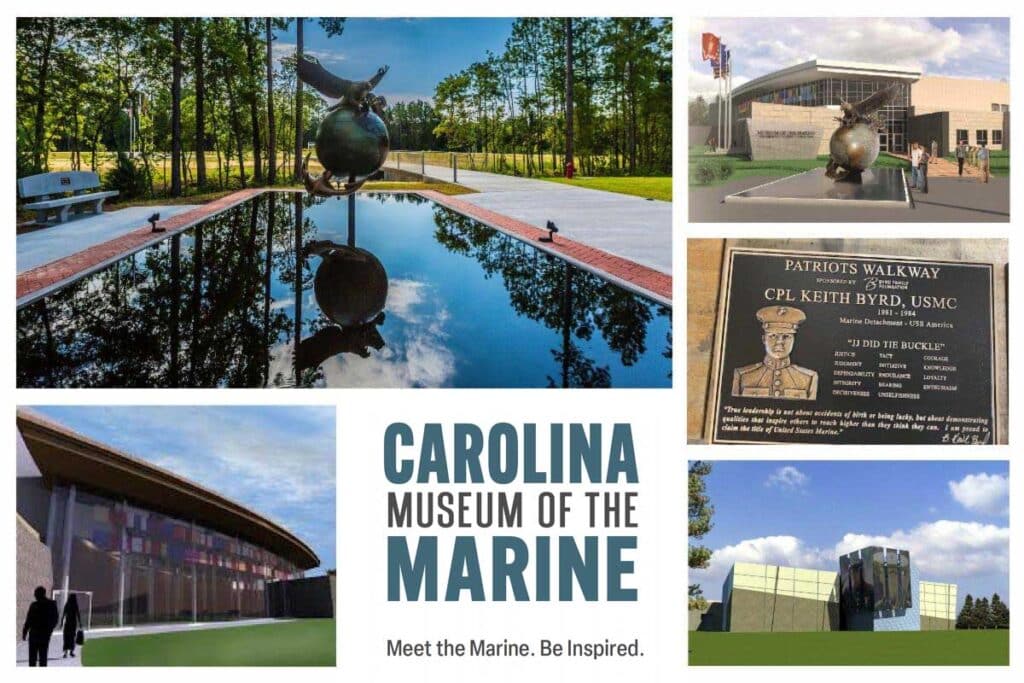Front and Center Vol 1 No 10 October 2022

FRONT AND CENTER
Vol. 1, No 10, October 2022
Mission
Honoring the legacy of Carolina Marines and Sailors and inspiring future generations.

A Message from the CEO
It has been said that “our passions are ignited when we set out to advance a cause greater than ourselves”. I think this statement aptly describes the mission of Carolina Museum of the Marine.
In my short time with the team, I have seen this “passion” in all our supporters, and it is a privilege to be part of a cause that honors the legacy of Carolina Marines and Sailors, sustains the ideals that are the foundation of our Nation, and inspires principle, committed citizens.

BGen Kevin Stewart, USMC (Ret)
Al Gray Marine Leadership Forum Essays
The intent of these essays is to create civil discourse and spur thought. In line with our mantra of “teaching how to think, not what to think” these essays are complex, and the issues addressed are difficult to navigate without sparking some disagreements.
We welcome this, as we work to inspire principled and committed leaders.
On the Founding Principles
of the United States
by James Danielson, PhD
Due process of law is enshrined in the American Constitution in the Fifth and Fourteenth Amendments, and we find it in Magna Carta some 550 years earlier. The idea is that before someone may be deprived of life, liberty, or property, that person must first be convicted in court by evidence tested by a process designed to reach the truth. Moreover, the people who will pass judgment on the evidence should be of the same social class as the accused because, it was thought, this maximizes the likelihood that juries will be impartial.

Most of what is written in Magna Carta is peculiar to life in England in the 13th century, but two sections of it express the principles of habeas corpus and of due process of law. In the early 13th century King John was acutely at odds with his barons who were angry at his treatment of them. Moreover, the Archbishop of Canterbury, Stephen Langton, was much disturbed by the King’s treatment of the Catholic Church in England. It is thought that Langton was the key impetus in rousing the barons to confront the King. King John, Langton, and the barons met in the meadow at Runnymede in June of 1215 to read and sign the Great Charter. The King had no intention of honoring the provisions of the Charter and appealed to Pope Innocent III to overturn it. On August 24, 1215, the Pope issued a Papal Bull declaring Magna Carta null and void. John found himself faced with war with the barons, but fell ill with dysentery and died on October 18, 1216 at the age of 50. John’s son, Henry III, re-issued Magna Carta, and his son, Edward I, affirmed the document. In 1863, the Statute Law Revision Act repealed most of the provisions of the Charter but left intact the provision for due process of law (the Habeas Corpus Act of 1679 made explicit the important principle that no magistrate can imprison someone without evidence presented in a court of law).
In our history, judges, using the Fourteenth Amendment, invented “substantive” due process in the 19th century. Substantive due process is the principle that the Fifth and Fourteenth Amendments protect fundamental rights from government interference. Specifically, the Fifth and Fourteenth Amendments prohibit the government from depriving any person of “life, liberty, or property without due process of law.” The Fifth Amendment applies to federal action, and the Fourteenth applies to state action. However, many judicial scholars believe substantive due process has no place at all in the Constitution. Due process of law, as it has existed in English and American history before the 19th century, is how the substance of a case is tried.
The idea of substantive due process can be found in a Supreme Court opinion in 1857, but it doesn’t become the judicial instrument that it has become until the 20th century when the Court determined that the due process clause in the Fourteenth Amendment “incorporated” the states into the Bill of Rights, thus giving the Supreme Court authority to strike down state laws for violating any of the rights enumerated in the first eight amendments to the Constitution. Some believe, the justices of the Supreme Court are moving toward recognizing that substantive due process reasoning violates the principle of federalism (about which more will be said later) because the tenth amendment declares all powers not delegated to the United States in the Constitution, nor prohibited by it to the states, are state powers. Thus, the logic follows that the Constitution does not give the federal government authority to strike down state laws enacted in pursuance of legitimate state authority. This, by the way, is what the Court did recently in overturning Roe v. Wade by returning the question of the legal status of abortion to the states and affirming that the practice of medicine within a state comes under the authority of each state, since states license and regulate the practice of medicine within their borders.
Clearly, we see wrangling over an important principle of government, due process of law, that has been going on at least since 1215. We see also, in our American Constitution, the important influence of political ideas that go back in history for much longer than our republic is old.

IN A NOT SO FAR OFF NORTHERN LAND; 1941-1942
THE 1st PROVISIONAL MARINE BRIGADE, ICELAND
by CWO5 Lisa Potts USMC (Ret)
In April 1940, Iceland was in a precarious position. Germany overran Denmark, whose King was still Iceland’s head of state. British forces occupied Iceland to defend against a hostile attack and deny the enemy an advantageous seaport to attack vital sea lines of communication.
On June 16, 1941, the First Provisional Marine Brigade was expeditiously assembled under the command of Brigadier General John Marston.[1] Under direct control of Commandant General Thomas Holcomb, the Brigade of 4,095 men was equipped with 90 days of supplies and ten units of fire. It was heavily staffed with enlisted veterans who had served in the Orient and in the tropical regions of the Western Hemisphere. “There was at the time a strong feeling of personal identity with the entire Corps…a feeling that arose from a vicarious knowledge on the part of the younger ones.”[2]
John L. Zimmerman, “Corps General Order No. 4-41, dated at Quantico, 14 June 1941, The First Marine Brigade (Provisional), Iceland 1941-1942. In Library of the Marine Corps, Quantico, VA: USMC (1946), 6. Ibid, 15.

Again, in nineteen forty-one
We sailed a northern course
And found beneath the Midnight Sun
The Viking and the Norse
This old Icelandic nation
We’ll defend by every means
And uphold the reputation
OF THE UNITED STATES MARINES [1]
In great secrecy, the Brigade embarked at Charleston, South Carolina onboard the armored cruisers that had brought the Sixth Marines (reinforced) from the West Coast. During a 24-hour watch at sea, a Marine sighted a life raft on the evening of July 5th. Four Red Cross women and ten Norse Sailors, whose ship had been torpedoed when it fell behind its convoy, were rescued.[1]
Once ashore, the Brigade’s mission, in cooperation with the British garrison, was to defend Iceland against hostile attack. A lack of resources and facilities required arduous working parties to unload supplies, build camps, and establish defensive positions alongside the British 49th (West Riding) Infantry Division. Wilson “Tom” Atkins, a mortarman with H/3/6, recalled “we worked around the clock. We had 24 hours of daylight, so we didn’t just work from sunup to sunset. We worked until the job got done.”[2] The 49th West Riding Commander honored the Marine Brigade by authorizing them to wear their Badge. “Iceland had given us so much. More than anything it had forged a firm and abiding link between all who wore the Polar Bear.”[3]
On August 16, 1941, an inspection was announced. At 10:30 a.m., the Sixth Marine Regiment (Rein) paraded on the paved highway running from Reykjavik to the northeast. A short time later, Prime Minister Winston Churchill and his entourage[4] walked the entire length of the U.S. Marine Corps and British lines, then reviewed the force. Standing tall, the multinational parade presaged the future Anglo-American alliance.
Just two days earlier, following a secret meeting aboard a warship off Newfoundland, U.S. President Franklin D. Roosevelt and British Prime Minister Churchill announced the epoch eight fundamental principles of the Atlantic Charter[5] verbally agreed upon: setting the stage for a post war alliance and the creation of the North Atlantic Treaty Organization.
Following the attack on Pearl Harbor, December 7, 1941, U.S Army units relieved the Marine Brigade. By March 1942, all elements of the Brigade had been transferred except a small working party. The Sixth Marines (Reinforced) reported back to the 2d Marine Division on the West coast. The Fifth Defense Battalion, 1st Engineer Bn, 1st Scout Company, and Bakery Units reported back to the 1st Marine Division at Marine Barracks, New River. The Headquarters Platoon and the Brigade Band reported to Quantico.
The Carolina Museum of the Marine is honored to preserve the rich legacy of the 1st Provisional Marine Brigade in Iceland, 1941-1942.
The 1st Provisional Marine Brigade, Iceland
Brigade Headquarters Platoon
Company A, 2nd Tank Battalion (less one Platoon)
Company C, 1st Engineer Battalion
3rd Platoon, 1st Scout Company
Chemical Platoon
Company A, 2nd Medical Battalion
1st Platoon, Company A, 2nd Service Battalion
Two Bakery Units
Band
6th Marines
2nd Battalion, 10th Marines
5th Defense Battalion (less 5” Artillery Group)

West Riding Polar Bear Patch from the Carolina Museum of the Marine collection
Badge was donated by the family of Marine PFC James Henry Flowers of Southport, NC, who served with the Brigade in Iceland and then in the Pacific theatre as a combat photographer.
[1] John L. Zimmerman, “Corps General Order No. 4-41, dated at Quantico, 14 June 1941, The First Marine Brigade (Provisional), Iceland 1941-1942. In Library of the Marine Corps, Quantico, VA: USMC (1946), 6.
[2] Ibid, 15.
[3] Ibid, 9.
[4] Tom Bartlett, “Polar Duty” Leatherneck (July 1992), 28.
[5] Patrick Delaforce, British Lt. quoted in The Polar Bears: Monty’s Left Flank: From Normandy to the Relief of Holland with the 49th Division, Stroud: Chancellor Press (1995), 19.
[6] Members of the Atlantic Charter secret meeting included Prime Minister Winston Churchill, British Army General Sir John Dill, Royal Navy Admiral Sir Dudley Pound, President Franklin D. Roosevelt, US Navy Admirals Ernest J. King and Harold R. Stark, US Army General George C. Marshall, and Presidential Adviser Harry Hopkins
[7]NATO – Official text: ‘The Atlantic Charter’ – Declaration of Principles issued by the President of the United States and the Prime Minister of the United Kingdom, 14-Aug.-1941 (accessed September 10, 2022)
CAROLINA MARINES
Marine Corps Base Camp Lejeune
Marine Corps Air Station Cherry Point
Marine Corps Air Station New River
Marine Corps Camp Geiger | Marine Corps Camp Johnson
Marine Corps Recruit Depot Parris Island
Marine Corps Air Station Beaufort
Marine Corps Auxiliary Landing Field Bogue
Marine Corps Outlying Field Camp Davis
Marine Corps Outlying Field Oak Grove
This issue of FRONT AND CENTER features
Marine Corps Outlying Field Camp Davis
Marine Corps Outlying Field (MCOLF) Camp Davis is a military use airport northeast of the central business district of Holly Ridge, in Onslow County, North Carolina. It is used as a training facility by the United States Marines of Camp Lejeune and Marine Corps Air Station New River.
Camp Davis was built in December 1942 by the United States Army as an anti-aircraft artillery training facility. Attached to the First Army, Fourth Corps Area, it held a complement of approximately 20,000 officers and soldiers and was an expansive facility consisting of more than 3,000 buildings on 45,538 acres with access provided by newly built railroad spurs leading into the camp.
Between 1942 and 1943, two 5,000 feet paved runways were built for Camp Davis Army Air Field (AAF). Part of the runway for the airfield was built through one of the through the walls of the Civil War fort. Camp Davis AAF’s Runway 5/23 was wider and was intended for use by transports, while Runway 19/01 was narrower and intended for use by single-engine aircraft. Most of the aircraft operated from Camp Davis runways were single-engine aircraft used to tow targets for the anti-aircraft artillery units. Women Airforce Service Pilots (or “WASPs”) towed targets at Camp Davis. At least two were killed in flying accidents there.
During World War II Camp Davis housed approximately 550 German prisoners. In 1944 the anti-aircraft training facility was transferred to Fort Bliss, and on 17 February 1946, Camp Davis was closed.
In June 1946, a portion of the Camp Davis area formerly used by the Army as the Coastal Artillery Anti-Aircraft Firing Range (present-day Surf City, North Carolina) was transferred to the United States Navy. The Navy temporarily used the site for the development and testing of early surface-to-air missiles under the name Operation Bumblebee until 28 July 1948 when Camp Davis was declared surplus and dismantled for salvage and sale. At that time, the Navy apparently gave up the leases on the land, and it was returned to the original landowners.
The Marine Corps took out a new lease in 1954 for approximately 955 acres on the former Camp Davis airfields & surrounding land from International Paper Company. In recent years, the Marine Corps has used Camp Davis as a landing field for helicopter units based at nearby Marine Corps Air Station New River. MCOLF Camp Davis has two runways which are designated 5/23 and 18/36.
(Photo https://www.2ndmaw.marines.mil/Photos/igphoto/2002602432/)
Please join us in supporting the mission of
Carolina Museum of the Marine
When you give to our annual campaign, you help to ensure that operations continue during construction and when the doors open!
Stand with us
as we stand up the Museum!

Copyright October, 2022
Carolina Museum of the Marine
2021-2022 Board of Directors
Executive Committee
Mr. Mark Cramer, JD – Acting Chair and Vice Chair
CAPT Pat Alford, USN (Ret) – Treasurer
Col Joe Atkins, USAF (Ret) – Secretary
Col John B. Sollis, USMC (Ret) – Immediate Past Chair
General Al Gray, USMC (Ret), 29th Commandant – At-Large Member
LtGen Gary S. McKissock, USMC (Ret) – At-Large Member
Members
Mr. Terry Branton
Mr. Tom DeSanctis
MGySgt Osceola Elliss, USMC (Ret)
Col Chuck Geiger, USMC (Ret)
Col Bruce Gombar, USMC (Ret)
LtCol Lynn “Kim” Kimball, USMC (Ret)
CWO4 Richard McIntosh, USMC (Ret)
CWO5 Lisa Potts, USMC (Ret)
Col Grant Sparks, USMC (Ret)
GySgt Forest Spencer, USMC (Ret)
Staff
BGen Kevin Stewart, USMC (Ret), Chief Executive Officer
Ashley Danielson, VP of Development
SgtMaj Joe Houle, USMC (Ret), Operations and Artifacts Director
Richard Koeckert, Accounting Manager
Carolina Museum of the Marine is a nonprofit organization that is rigorously nonpartisan, independent and objective.


